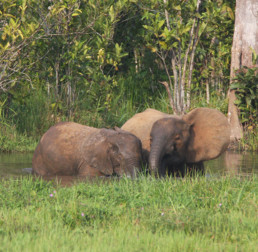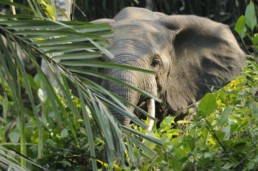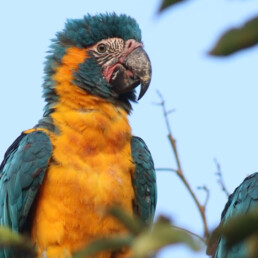Critically Endangered
The African Forest Elephant is the smallest of the three living elephant species, and is native to the humid tropical forests in West Africa and the Congo Basin. In fact it only became its own species in 2021. Before that all African elephants were considered to be the same species: Loxodonta africana. It was only in 2021 that the taxonomy was finally changed to match what scientists had long argued: that the forest elephant, Loxodonta cyclotis, is its own species, separate from the African savanna elephant (Loxodonta africana). That same year African elephants were downgraded from Vulnerable on the IUCN Red List to Endangered for the African savanna elephant and Critically Endangered for the newly split African forest elephant.

The Mega-gardener of the Forest
Forest elephants are smaller than their savannah cousins and have straighter, downward-pointing tusks, which are thinner and harder than the tusks of the savannah elephants and are used to push through the dense undergrowth of their habitat. They have smoother skin, in contrast to the moisture collecting wrinkled skin of savannah elephants. They also have rounder ears, from which they derive their Latin name cyclotis. Bulls of the species reach a shoulder height of 2.4–3.0 m. Females are smaller at about 1.8–2.4 m tall at the shoulder.

Photo by dsg-photo.com – Own work, CC BY-SA 3.0
African forest elephants, like their savannah and Asian cousins, can live for up to 65 years and are considered ‘gardeners of the forest’. Forest elephants need to eat a huge amount of vegetation to extract the nutrients required to power the biological machine that is an elephant’s massive body, meaning that they are capable of changing the vegetation structure of a forest.
The dung produced is also an incredible fertilizer, and the seeds of fruits or acacia pods pass through the elephant undigested, dispersing plant species and regenerating the forest. They are highly social and live in family groups of up to 20 comprised of adult cows, their daughters and subadult sons. Family members look after calves together, called allomothering.
Once young bulls reach sexual maturity, they separate from the family group and form loose bachelor groups for a few days, but usually stay alone. Adult bulls associate with family groups only during the mating season. Family groups travel about 7.8 km per day and move in a home range of up to 2,000 km 2 , moving according to the availability of ripe fruits in the forest. Their complex network of permanent trails pass through stands of fruit trees and connect forest clearings with mineral licks, and are reused by humans and other animals.

Group of African forest elephants digging at a mineral lick.
African Forest Elephants once occurred across the entire humid forest area of western and central Africa bu their range is decreasing and is highly fragmented in western Africa where seven range countries are reported to have fewer than a hundred each. The majority of the remaining population is found in six central African countries where they occupy an estimated 25% of their former range.
A dire situation
Compared to savanna elephants, the forest elephant is in much more serious danger of becoming extinct. Both African elephant species are threatened primarily by habitat loss and habitat fragmentation following conversion of forests for plantations of non-timber crops, livestock farming, and building urban and industrial areas. As a result, human-elephant conflict has increased. Poaching for ivory and bushmeat is a significant threat in Central Africa. The forest elephant population has declined by approximately 95% in the past 100 years due to the advent of modern firearms.
Around 50% of all surviving forest elephants are now in Gabon, despite Gabon only covering 13% of the total forest area of the region. Around 95% of the forests of the Democratic Republic of Congo, one of the largest countries in Africa and the epicentre of Africa’s tropical rainforest eco-system, is likely to be almost empty of elephants.











